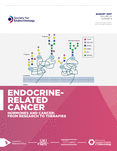Brachyury, a vaccine target, is overexpressed in triple-negative breast cancer
- Duane H Hamilton1,
- Mario Roselli2,
- Patrizia Ferroni3,
- Leopoldo Costarelli4,
- Francesco Cavaliere5,
- Mariateresa Taffuri4,
- Claudia Palena1⇑ and
- Fiorella Guadagni3,6
- 1Laboratory of Tumor Immunology and Biology, Center for Cancer Research, National Cancer Institute, NIH, Bethesda, Maryland, USA
- 2Department of Systems Medicine, Medical Oncology, Tor Vergata Clinical Center, Tor Vergata University of Rome, Rome, Italy
- 3San Raffaele Roma Open University, Rome, Italy
- 4Department of Pathology, San Giovanni Hospital-Addolorata, Rome, Italy
- 5Department of Surgery, San Giovanni Hospital-Addolorata, Rome, Italy
- 6Interinstitutional Multidisciplinary Biobank (BioBIM), IRCCS San Raffaele Pisana, Rome, Italy
- Correspondence should be addressed to C Palena; Email: palenac{at}mail.nih.gov
Abstract
Patients diagnosed with triple-negative breast cancer (TNBC) have a high rate of tumor metastasis and a poor prognosis. The treatment option for these patients is currently chemotherapy, which results in very low response rates. Strategies that exploit the immune system for the treatment of cancer have now shown the ability to improve survival in several tumor types. Identifying potential targets for immune therapeutic interventions is an important step in developing novel treatments for TNBC. In this study, in silico analysis of publicly available datasets and immunohistochemical analysis of primary and metastatic tumor biopsies from TNBC patients were conducted to evaluate the expression of the transcription factor brachyury, which is a driver of tumor metastasis and resistance and a target for cancer vaccine approaches. Analysis of breast cancer datasets demonstrated a predominant expression of brachyury mRNA in TNBC and in basal vs luminal or HER2 molecular breast cancer subtypes. At the protein level, variable levels of brachyury expression were detected both in primary and metastatic TNBC lesions. A strong association was observed between nuclear brachyury protein expression and the stage of disease, with nuclear brachyury being more predominant in metastatic vs primary tumors. Survival analysis also demonstrated an association between high levels of brachyury in the primary tumor and poor prognosis. Two brachyury-targeting cancer vaccines are currently undergoing clinical evaluation; the data presented here provide rationale for using brachyury-targeting immunotherapy approaches for the treatment of TNBC.
- Received 5 August 2016
- Accepted 9 August 2016
- Made available online as an Accepted Preprint 31 August 2016
- © 2016 Society for Endocrinology












